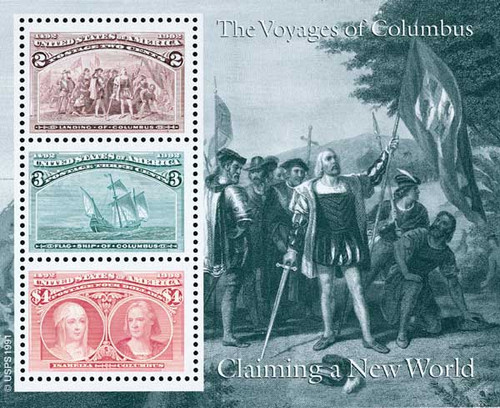
# 2624-29 - 1992 Columbian Souvenir Sheets, set of 6
US #2624-29
1992 Columbian Souvenir Sheets
- Issued to celebrate 500th anniversary of first voyage of Columbus to New World
- Created with same dies as original Columbian stamps
- Part of a four-way joint issue
Category of Stamp: Commemorative
Value: $16.34
First Day of Issue: May 22, 1992
First Day City(s): Chicago, Illinois
Quantity Issued: 2,000,000
Printed by: American Back Note Company - LA
Printing Method/Format: Offset Lithography and Intaglio
Perforations: 10.5
Reason the stamp was issued: This set of six souvenir sheets was issued to commemorate the 500th anniversary of Christopher Columbus’s first voyage to the New World.
About the stamp design: The Columbian stamps issued in 1893 were America’s first commemoratives. They became favorites among collectors. The USPS used the die from the originals stamps to create the modern versions. The sixteen denominations were issued as six souvenir sheets.
Special design details: In order to make changes to the stamp images without altering the original dies, special transfers were made. The original date, 1893, was replaced with 1992. Flaws in the original dies that resulted from their age were repaired in the duplicates.
About the printing process: Ink colors were chosen for the stamps to reflect the colors of the original Columbian stamps. The images on the border of the sheets were produced using dark colors so the focus remained on the stamps rather than being distracted by the accompanying images. The stamp images were printed using intaglio engraving, and the background images were produced using offset lithography.
First Day City: The dedication ceremony for the Columbian souvenir sheets took place on opening day of World Columbian Stamp Expo 92. Joint issue sheets from Italy, Portugal, and Spain were also dedicated at the ceremony.
Unusual thing about this stamp: These six souvenir sheets were sold only as a set by the US Postal Service. Originally, they were only available at the Expo or through mail order from the Philatelic Sales Division. Later, the USPS announced the sheets would be sold at local post offices.
More fun facts: This set was a joint issue with Italy, where Columbus was born, Portugal, whose flag he sailed under, and Spain, where Columbus received financial backing from the monarchs.
History the stamp represents: In 1893, the World’s Columbian Exposition was held in Chicago. It commemorated the 400th anniversary of Christopher Columbus sailing to the New World on his first voyage. A set of 16 stamps were issued to commemorate the expo. They highlighted scenes from his journeys and his return to Europe. These stamps became favorites among stamp collectors, though few people were able to afford the entire set of 16. In anticipation of the 500th anniversary, the USPS decided to reissue those beloved stamps using the same denominations.
US #2624-29
1992 Columbian Souvenir Sheets
- Issued to celebrate 500th anniversary of first voyage of Columbus to New World
- Created with same dies as original Columbian stamps
- Part of a four-way joint issue
Category of Stamp: Commemorative
Value: $16.34
First Day of Issue: May 22, 1992
First Day City(s): Chicago, Illinois
Quantity Issued: 2,000,000
Printed by: American Back Note Company - LA
Printing Method/Format: Offset Lithography and Intaglio
Perforations: 10.5
Reason the stamp was issued: This set of six souvenir sheets was issued to commemorate the 500th anniversary of Christopher Columbus’s first voyage to the New World.
About the stamp design: The Columbian stamps issued in 1893 were America’s first commemoratives. They became favorites among collectors. The USPS used the die from the originals stamps to create the modern versions. The sixteen denominations were issued as six souvenir sheets.
Special design details: In order to make changes to the stamp images without altering the original dies, special transfers were made. The original date, 1893, was replaced with 1992. Flaws in the original dies that resulted from their age were repaired in the duplicates.
About the printing process: Ink colors were chosen for the stamps to reflect the colors of the original Columbian stamps. The images on the border of the sheets were produced using dark colors so the focus remained on the stamps rather than being distracted by the accompanying images. The stamp images were printed using intaglio engraving, and the background images were produced using offset lithography.
First Day City: The dedication ceremony for the Columbian souvenir sheets took place on opening day of World Columbian Stamp Expo 92. Joint issue sheets from Italy, Portugal, and Spain were also dedicated at the ceremony.
Unusual thing about this stamp: These six souvenir sheets were sold only as a set by the US Postal Service. Originally, they were only available at the Expo or through mail order from the Philatelic Sales Division. Later, the USPS announced the sheets would be sold at local post offices.
More fun facts: This set was a joint issue with Italy, where Columbus was born, Portugal, whose flag he sailed under, and Spain, where Columbus received financial backing from the monarchs.
History the stamp represents: In 1893, the World’s Columbian Exposition was held in Chicago. It commemorated the 400th anniversary of Christopher Columbus sailing to the New World on his first voyage. A set of 16 stamps were issued to commemorate the expo. They highlighted scenes from his journeys and his return to Europe. These stamps became favorites among stamp collectors, though few people were able to afford the entire set of 16. In anticipation of the 500th anniversary, the USPS decided to reissue those beloved stamps using the same denominations.











